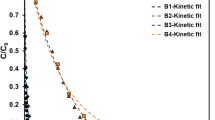Abstract
Calculations have been performed to investigate long timescale redox control in a cementitious deep waste repository, once there has been significant corrosion of the steel containers in the near field. The methodology considers reaction of the porewater with redoxsensitive solids. The solids were selected based on considerations of the repository concept, the waste inventory and the processing of the waste into a form suitable for disposal. A number of factors that may affect the redox potential have been considered. Amongst these are the form of the redox-controlling solids, the effect of changes in pH, the effect of sorption onto the cementitious backfill, and the effect of the association of dissolved radionuclides with complexants arising from the degradation of organic wastes. The calculations suggest that for the United Kingdom Nirex Limited (Nirex) disposal concept and inventory, the redox system in the near field of the repository would be controlled by the iron(II)/iron(III) redox couple. This would maintain the redox potential in the repository near field at a low value for timescales in excess of 1 million years.
Similar content being viewed by others
References
J.E. Goldberg, L.J. Gould, T.G. Heath, A.M. Thompson and C.J. Tweed, Development of a Methodology for Modelling the Redox Chemistry and Predicting the Redox Potential of the Near Field of a Cementitious Radioactive Waste Repository, Nirex Report NSS/R398, 1995.
A.V. Chambers, S.J. Williams and S.J. Wisbey, Nirex Near Field Research: Report on Current Status in 1994, Nirex Science Report S/95/011, 1995.
I. Grenthe, J. Fuger, R.J. Lemire, A.B. Muller, C. Nguyen-Trung Cregu and H. Wanner, Chemical Thermodynamics of Uranium, Vol. 1, Nuclear Energy Agency, OECD, Elsevier, 1992.
R.J. Silva, G. Bidoglio, M.H. Rand, P.B. Robouch, H. Wanner and I. Puigdomenech, Chemical Thermodynamics of Americium, Vol. 2, Nuclear Energy Agency, OECD, Elsevier, 1995.
K.A. Bond, T.G. Heath and C.J. Tweed, HATCHES: A Referenced Thermodynamic Database for Chemical Equilibrium Studies, Nirex Report NSS/R379, 1997.
United Kingdom Nirex Limited, Post-closure Performance Assessment: Gas Generation and Migration, Nirex Science Report S/94/003, 1994.
A.J. Baker, A.V. Chambers, C.P. Jackson, J.D. Porter, J.E. Sinclair, P.J. Sumner, M.C. Thome and S.P. Watson, Nirex 97: An Assessment of the Post-closure Performance of a Deep Waste Repository at Sellafield, Volume 3: The Groundwater Pathway, Nirex Science Report S/97/012, 1997.
United Kingdom Nirex Limited, The Hydrochemistry of Sellafield.: 1995 Update, Nirex Science Report S/95/008, 1995.
United Kingdom Nirex Limited, The Physical and Chemical Characteristics of UK Radioactive Wastes, Report No 696, 1996.
Author information
Authors and Affiliations
Rights and permissions
About this article
Cite this article
Heath, T.G., Tweed, C.J. A Model for Redox Control in A Cementitious Repository. MRS Online Proceedings Library 556, 1245 (1998). https://doi.org/10.1557/PROC-556-1245
Published:
DOI: https://doi.org/10.1557/PROC-556-1245




